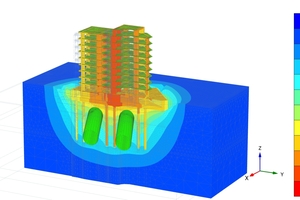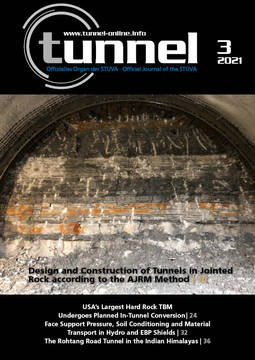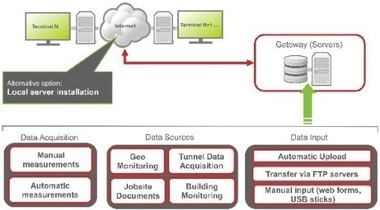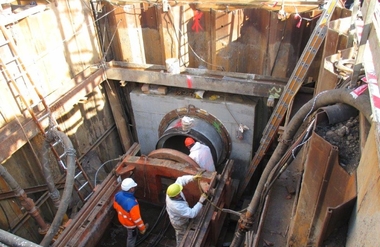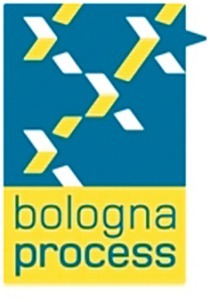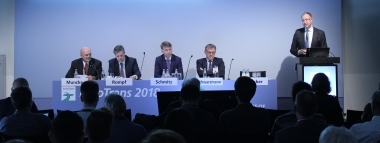Nine-Story Residential Building above SubwayTunnels in Bucharest
For tunnelling projects in inner-city areas, geotechnical modelling of the ground and monitoring during the construction phase ensure that the existing surface development is not damaged by ground subsidence caused by the underground construction measures. On the other hand, existing tunnel systems can also be protected in the same way if new building construction projects are being realised in the immediate vicinity of the alignment – such as in the Romanian capital Bucharest, which is criss-crossed by five underground metro lines with a total length of almost 80 km.
In western Bucharest, a residential building is being constructed over existing subway tunnels. The project includes nine aboveground floors and a basement-level parking area. The Romanian company Saidel Engineering was tasked with reducing the influence of the building on the tunnel lining, providing a safe and cost-efficient pile-foundation solution.
Geotechnical Analysis Software Plaxis
from Bentley
For this purpose, the geotechnical analysis software
Plaxis from Bentley Systems was applied. “Plaxis can be used quite effectively for surface settlements in tunnelling. You can conduct analyses both in terms of settlements that come through at the top surface or induced settlement on existing infrastructures. But geotechnical engineers also use Plaxis to analyse the development of structural forces and stresses on the tunnel lining itself, and these analyses can be performed for a wide variety of materials, ranging from soft soil to hard rocks,” said Jana Miller. Manager for Product Marketing, Engineering and Geotechnical Analysis at Bentley Systems.
As a long-time Plaxis user, Saidel Engineering knew it would be a suitable geotechnical application to use for this complex project. “Our team members have been successfully using the Plaxis software suite since 2000 for various international projects and the most complex deep excavation works and foundation systems for tall buildings in Romania,” explained Ion Raileanu, deputy managing director and head of the design department at Saidel. “Through monitoring of constructions during both the construction and service periods, the results of the geotechnical analyses were confirmed. The features of this software, namely advanced constitutive models for the simulation of non-linear behavior of soils, joint elements to model soil-structure interaction, staged construction enabling a realistic simulation of construction and other special elements, make it suitable for the numerical analysis of all geotechnical analyses.”
The team developed 3D models and compared the results to the original 2D models, providing them with confidence that the foundation would not have an adverse impact on the tunnels below it. The influence on the tunnel lining was analyzed for all the relevant stages of construction and can continue during its operation lifetime.
After the construction project was launched in December 2018, Saidel Engineering was able to complete the geotechnical analysis as early as spring 2019. The project has not yet entered the construction phase, though: the originally planned start of construction in autumn 2020 had to be postponed due to the corona restrictions.
Model Project for Future Comparable
Construction Measures
Ion Raileanu and Serban Nicolau, FEM design engineer at Saidel Engineering, explained the procedure and objectives of the geotechnical analysis in an interview. “We worked closely with the operating company Metrorex and Metroul S.A.” said Serban Nicolau. Metroul, responsible for the design and planning of the metro system in Bucharest, provided Saidel Engineering with the necessary data on the inner lining and reinforcement of the affected tunnel section.
With additional site visits in the tunnel, the engineers were able to get a comprehensive picture of their task to design the building foundation in such a way that not only structural damage to the tunnel directly below is excluded but also increased water ingress due to cracking is avoided. “Based on this information, we prepared our geotechnical report and finally sent it to Metroul for acceptance.” The project is the first building construction project in Bucharest that has received the approval of the metro operators to be built directly above an existing tunnel section.
“We have our own department that is in charge of monitoring our projects,” adds Ion Raileanu. “Back analyses are also carried out here, with which we validate the results of our original calculation. As long as the building is standing, we will carry out annual settlement monitoring. If at any time the actual settlements are more than 80% of what we calculated, additional monitoring measures will be initiated.”
According to Saidel Engineering, this current project unlocks the potential of other areas in Bucharest over tunnels, providing a model to follow for other similar projects.

